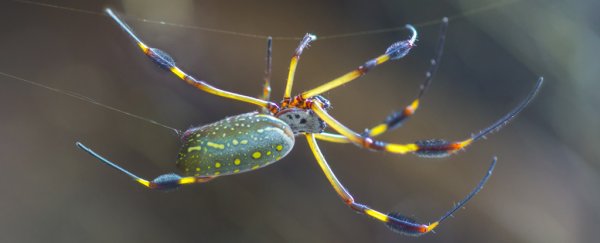As if spiderwebs weren't already icky enough, some spiders have gone and made them poisonous as well, a new study reveals.
The unique properties of spiderwebs have long fascinated materials scientists. They're constructed from one of the toughest known natural materials: lighter, yet five times stronger than steel, and bacteria resistant to boot.
Spider silk is also shudder-inducingly sticky and impressively elastic. You'd think these qualities alone are sufficient to capture prey, but it turns out the webs spiders construct with their silk do more than just act as a trap. New research suggests orb-weaving spiders also lace their webs with neurotoxins.
Back in 2011, a study found the golden orb weavers (Trichonephila antipodiana) of Asia and Australia lace their webs with a chemical repellent, to keep other creepy crawlies away from their larder of prey, and possibly to also avoid becoming dinner themselves.
The chemical, called 2-pyrrolidinone, deters moths, caterpillars and ants among others. But only the larger spiders, whose webs are thick enough to carry their more substantial weight, bothered to do this. Smaller spiders, whose webs are too fragile to even support ants, don't seem to bother with such fancy chemicals.
Now, molecular biologist Fanciele Grego Esteves from University of São Paulo State and colleagues have analysed the molecules that ooze out from spider silk-producing glands of the striking T. clavipes.
These colourful spiders are large orbweavers (although the females are significantly larger than males) from the Americas, that create elaborate gold-glowing webs 1-2 metres (up to 6.5 ft) in diameter. They are not aggressive and while their bites can cause some discomfort, like most spiders, they're harmless to humans.
Orbweavers can have up to seven types of silk-producing glands that exude threads with different purposes, including egg protecting, web scaffolding, and sticky prey capturing silk. The researchers analysed the contents of all seven types of glands and found a range of neurotoxin-like proteins similar to those in spider venom.
Once exuded from the spider's glands, these toxins were suspended across the web's capturing silk in drops of sticky oil, mostly composed of fatty acids.
The team tested these substances, washed off from the silk web, on bees (Apis mellifera) and confirmed they're paralytic and even lethal to the spider's natural prey when injected. The researchers also found the fatty acids may allow the toxins to enter the prey's body - as they disintegrated the waxy protective layer of bee cuticles.
"The findings from the current investigation may be relevant for scientists in several disciplines in life, environmental and toxinology sciences, forming a database and facilitating the design of future studies," Esteves and colleagues wrote in their paper.
Other researchers caution that we still need evidence these toxins actually work quickly and effectively just upon contact with prey species; the team plans to look further into this. These compounds could have other purposes, like the ant deterrence of 2-pyrrolidinone. But so far, the evidence is compelling.
So, not only do these spiders' webs function as a trap, they may also do the energy intensive and dirty work of subduing and possibly killing prey. If so, nice outsourcing, T. clavipes, we see what you did there.
This paper was published in the Journal of Proteome Research.
